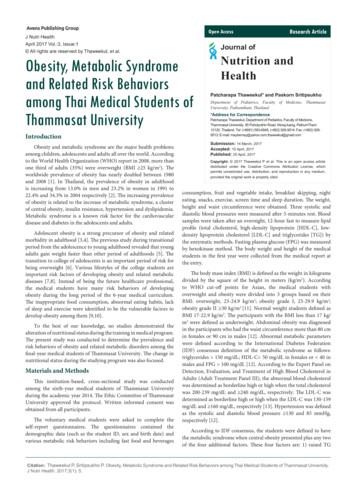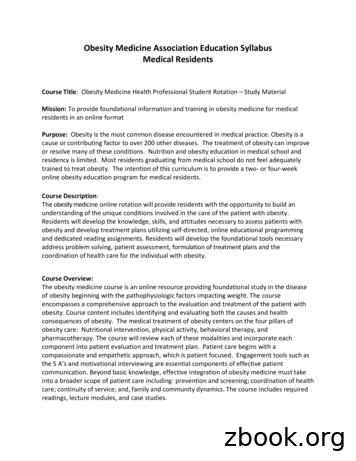Why Talk About Obesity?
Why have this workshop? Nursing represents the largest sector of thehealth professionsVillanova University The pervasive reach of nursing care makesnurses an ideal audience for nutritioncompetency training which can ultimatelyimprove patient care and health outcomesM. Louise Fitzpatrick College of NursingMacDonald center for obesityprevention and education (COPE)Why talk about obesity? Prioritizing obesity education within nursingcurricula and continuing education positionshealthcare professionals to combat thesurging obesity epidemic.Why talk about obesity? Bipartisan Policy Center: Provider Competencies for thePrevention and Management of Obesity establishescompetencies in obesity care for healthcare training. “Urgent call to action” aims to equip nurses with the tools tocombat obesity and help shape the future health of thiscountry (State of Obesity Report, tion-and-Management-of-Obesity(1).pdfAgendaWeight Bias What is weight bias? What observations have you made aboutweight bias in healthcare? Consequences of weight bias in healthcare? Weight Bias sensitivity training-Video Steps to reduce weight bias in your practice.Weight bias refers to negative stereotypesdirected toward individuals affected by excessweight or obesity, which often lead to prejudiceand discrimination.1
Observations? What observations have you seenregarding weight bias in healthcare?Weight Bias According to the CDC, 2/3 of American Adults areoverweight or obese. Weight bias is found in many settings: workenvironments, educational settings, media, and thehealthcare arena Negative stereotypes suggest that obese persons are toblame for their weight This form of bias is rarely challenged and leads torejection, prejudice, and discriminationProviders have been documentedto view obese patients asWeight Bias has been documented inPhysiciansNursesMedical StudentsPsychologistsDietitiansFitness ProfessionalsPuhl & Brownell, 2001; Puhl & Heuer, 2009 NoncompliantLazyLack self-controlAwkwardWeak ante et al., 2009; Campbell et al., 2000; Fogelman et al., 2002; Foster, 2003;Hebl & Xu, 2001; Price et al., 1987; Puhl & Heuer, 2009; Huizinga et al., 2010How is patient care affected? Providers tend to:– Spend less time in appointments– Engage in less discussion with patients– Assign more negative symptoms– Be less likely to send for additional testingBacquier et al., 2005; Bertakis & Azari, 2005; Campbell et al., 2000;Galuska et al., 1999; Hebl & Xu, 2001; Kristeller & Hoerr, 1997; Price et al., 1987Consequences for Weight Bias Patients may avoid or delay preventativeservices These decisions are attributed to:– Patients feeling disrespected from providers– Negative provider attitudes– Feeling embarrassed to be weighed– Office spaces/medical equipment to small forobese persons– Amy et al. (2006) Int J Obesity2
Questions to Consider What are your current views about patients withobesity?Video Weight Bias In Healthcare Video How comfortable are you working with yourpatients of different sizes? What kind of feedback do you give your patientswith obesity? Are you sensitive to the needs and concerns ofindividuals with obesity?www.uconnruddcenter.org/weighbias Source: UConn Rudd Center for Food Policy & ObesityAfter the video:Discussion QuestionsAfter the video:Discussion Questions Have you experienced any challenges in providing treatmentto patients with obesity? If so, what were these challenges?How did you deal with these obstacles? In light of the challenges that providers confrontwhen treating patients with obesity, what kind ofstrategies can providers use to ensure sensitive,compassionate care that is free of weight bias? What do you think are the most common stereotypes aboutindividuals with obesity? Do you believe that thesestereotypes are generally true or false? Do you think that stereotypes about persons with obesitycould affect the way that they are treated by healthprofessionals? If yes, in what ways do you think their caremay be compromised? If no, why not? How can health care providers improve theircommunication strategies with patients withobesity to encourage healthful behavior changePATIENT CHALLENGES3
Obesity is a MultifactorialDisease Variables include:– Biology– Physical activity environment– Individual physical activity– Individual psychology– Societal influences– Food environment– Food consumptionMetabolic Factors InfluenceWeight Individual Cultural andEconomic FactorsPhysiologic Factors Hunger and satiety Proteins affect the regulation of appetiteand storage of body fat Hunger hormones– Leptin, Ghrelin, Peptide YYRelatively low metabolic rateLow level of spontaneous physical activityLow sympathetic nervous system activityLow fat oxidationAbnormally low level thyroid hormoneCertain prescription medications Religious beliefsLearned food preferencesFast-food cultureDining outSedentary lifestyleEconomic statusAccess to healthcareIndividual Psychological andSocial Factors Appetite: psychological drive to eat Meal timing and size: portion distortion External cues: Sight and fragrance offoods Mood – depression, stress, aneixty Personal Barriers to physical activity Technological lifestyle Social pressures4
Scenario June 10th, 2017: Patient Y presents at her follow up appointmentfor a follow up for her newly diagnosed diabetes.Following her intake, her report details herweight of 348 pounds ( 7lbs since previous visiton May 2nd, 2017); BP 170/77mmHG, HgA1C9.5. Patient appears uncomfortable when you enterthe room and is avoiding eye contact. How do you navigate this conversation?Sensitive LanguageConsider this language in your discussionswith patients about their weight:– “Could we talk about your weight today?”– “How do you feel about your weight?”– “What words would you like to use when wetalk about ploads/Weight-Bias-in-Healthcare1.pdfUse People First LanguageWord Choice Rather than saying “obese adults” usephrasing words such as “adults withobesity” or “adults who are overweight orobese”Puhl R. Motivating or stigmatizing? public perceptions of weight‐related language used byhealth providers. International journal of obesity. (2005). 2013;37(4):612; 612‐619; 619.Avoid Blame Most patients with obesity have tried numeroustimes to lose weight- and have beenunsuccessful Conventional methods ineffective Need to consider genetic factors Often not related to a lack of discipline orwillpower Complex condition attributed to by multipleenvironmental factorsThe weight conversation Start by listening– start with an empathetic statement– ask permission before bringing up topic of weight– If the patient makes it clear they do not want to have thisdiscussion today, respect that choice and table the conversationfor another time. Assess Readiness– assess their readiness for behavioral change in order to informthe conversation.– One approach characterizes patients in one of five “stages ofchange”: pre‐contemplation, contemplation, preparation, action,or maintenance.STOP Provider Discussion Tool5
The weight conversation Communication strategies:– Motivational Interviewing help motivate the patient in a collaborative nature, understand the patient’sperspective, and assist the patient in finding his or her own solutions, whileaffirming the patient’s freedom to change.– Constructive and respectful feedback– Clear and direct advice, with emphasis that patient makesultimate choice to change.– Listen to and reflect on the patient’s statements and feelings– Active listening “What things would change if you accomplished your weight loss b628b687967200f896ab417b8.jpgThe weight conversationSTOP Provider Discussion ToolRecap:What to do and what NOT to do Physical Activity– Ask patients how often they exercise each week and for howlong– Discuss the health risks of a sedentary lifestyle and theimportance of even a little bit of movement every day– Ask what small steps they could very easily take to incorporatemore physical activityImplicit Weight Bias Test In order to effectively facilitate change inweight bias, providers must identify andovercome their own implicit and explicitweight-based biases. ml http://whyweightguide.org/videos.phpResources to Address Weight Bias:Improving Obesity Care ContinuingMedical Education (CME) Course Developed by the UConn Rudd Center for Food Policyand Obesity and the University of Connecticut Schoolof Medicine, this free, one-hour, online accreditedcourse is for health professionals (clinicians, nurses,social workers and dietitians, and trainees) to improvethe quality of care for patients with overweight andobesity, and help reduce weight stigmatization inclinical settings.http://ruddcentercme.org/6
Final Tips Don’t laugh at “fat” jokes. Make negative weight-related commentsunacceptable. Avoid making comments about others’weight that tie to character. Stick up for others who are victims ofweightismWhat steps can you take tominimize weight bias inyour practice?Resources "I've learned that people will forget whatyou said, people will forget what you did,but people will never forget how you madethem feel."-- Maya Angelou STOP Obesity Alliance Obesity Action Coalition UConn Rudd Center for Food Policy andObesity The State of Obesity The Obesity Society7
combat obesity and help shape the future health of this country (State of Obesity Report, 2017). . Weight bias refers to negative stereotypes directed toward individuals affected by excess weight or obesity, which of
Prevalence of obesity and severe obesity in US children, 1999‐2014. Obesity, 2016 May;24(5):1116-23. Wang et al. What childhood obesity prevention programmes work? A systematic review and meta-analysis. Obes Rev, 2015 Langford et al. Obesity prevention and the Health Promoting Schools framework: essential components and barriers to .
Obesity Obesity is a disease where a person’s weight is in an unhealthy range (BMI of 30.0-39.9). It is a disease that can lead to other health problems. Talk with your healthcare provider to better understand and treat obesity. Severe Obesity Someone who is more than 100 pounds over their
2. Obesity trends and co-morbid consequences. 3. Poverty, obesity and food econo-mics. 4. Genetics and Caribbean culture. 5. The cost of obesity to develop-ment. Dimensions 1- Obesity Epide-miology: Prevalence, Age and Gender Relationships The most striking features of Figure 1 are (a) the high prevalence of overweight (BMI 25) and obesity
of obesity is related to the increase of metabolic syndrome, a cluster of central obesity, insulin resistance, hypertension and dyslipidemia. Metabolic syndrome is a known risk factor for the cardiovascular disease and diabetes in the adolescents and adults. Adolescent obesity is a strong precursor of obesity and related morbidity in adulthood .
Obesity Medicine Association Education Syllabus Health Professional Students Course Title: Obesity Medicine Health Professional Student Rotation – Study Material Mission: To provide foundational information and training in obesity medicine for health professional students in an online format Purpose: Obesity is the most common disease encountered in medical practice.
Obesity Medicine Association Education Syllabus Medical Residents Course Title: Obesity Medicine Health Professional Student Rotation – Study Material Mission: To provide foundational information and training in obesity medicine for medical residents in an online format Purpose: Obesity is the most common disease encountered in medical practice.
1.1 Childhood obesity 13 1.2 Key global strategies related to obesity prevention 13 1.3 WHO Forum and Technical Meeting on Population-based Prevention Strategies for Childhood Obesity 15 1.4 Purpose and structure of the document 15 Guiding principles for the development of a population-based childhood obesity prevention strategy 16
Final 2012 policy CMS will implement the third year of the 4-year transition to new practice expense RVUs developed using the PPIS data. Available in the appendix of this summary, Table 84 of the .























